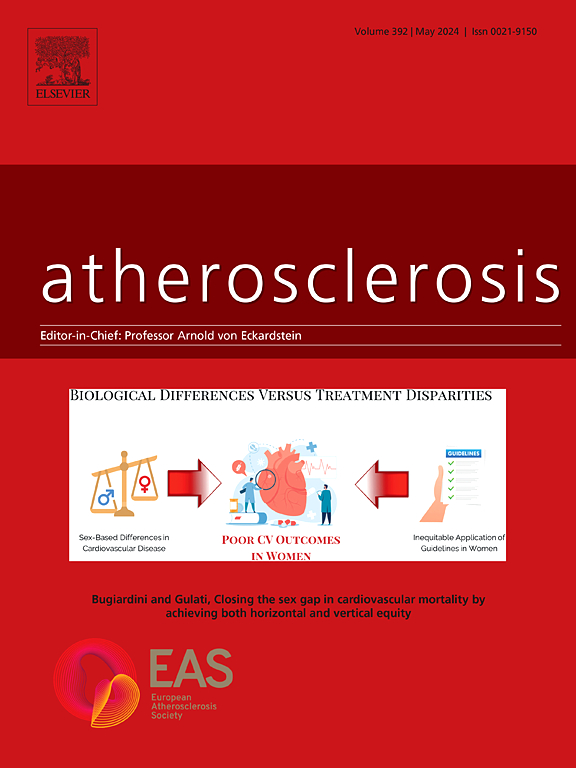急性心肌梗死后6个月血清脂质组的变化及其与冠状动脉斑块的关系
IF 4.9
2区 医学
Q1 CARDIAC & CARDIOVASCULAR SYSTEMS
引用次数: 0
摘要
背景和目的测量血液中的脂质种类有望识别与冠状动脉粥样硬化相关的新生物标志物。在这里,我们研究了在指南推荐治疗的患者急性心肌梗死(MI)后循环脂质种类与冠状动脉斑块变化之间的关系。方法:在这项对INFLAME研究的事后分析中,出现心肌梗死的患者在入院期间和6个月的随访期间接受了血清脂质组学分析和冠状动脉计算机断层扫描血管造影(CCTA)。对最高级别的非罪魁祸首狭窄进行定量CCTA斑块分析。混合靶向/非靶向液相色谱质谱分析策略用于鉴定与斑块测量相关的脂质变化。结果来自24名参与者的48个配对样本,具有完整的影像学和生化数据集,构成了研究基础。两种鞘脂类鞘磷脂(SM) (p.adj<0.001)和神经酰胺(Cer) (p.adj = 0.02)在心肌梗死后降低,而溶血磷脂酰胆碱(p.adj<0.001)和溶血磷脂酰乙醇胺(p.adj = 0.04)升高。在多变量线性回归分析中,lpc15:0或磷脂酰胆碱(pc39:6)每降低一个标准差,总斑块负担减少4%。此外,LPC 15:0的减少与低衰减斑块负担的减少有关,LPC 18:0和pc39:6的减少与非钙化斑块负担的减少有关。同样,鞘脂(Cer d43:1和SM d38:2)每减少一个标准差,低衰减斑块组成就会减少4%。结论:在心肌梗死后早期,指南推荐的治疗伴随着鞘脂降低、溶脂升高和脂质亚类脂肪酸组成的改变,一些脂质组学改变与冠状动脉斑块特征的有利改变有关。本文章由计算机程序翻译,如有差异,请以英文原文为准。

Changes to the serum lipidome and their relation to coronary plaque in the first six months after acute myocardial infarction
Background and Aims
The measurement of lipid species in blood holds promise for identifying new biomarkers associated with coronary atherosclerosis. Here, we examined for relationships between circulating lipid species and coronary plaque changes following acute myocardial infarction (MI) in patients on guideline-recommended treatment.
Methods
In this post-hoc analysis of the INFLAME study, patients presenting with MI underwent serum lipidomic analysis and coronary computed tomography angiography (CCTA) during admission and at 6-month follow-up. Quantitative CCTA plaque analysis was performed on the highest-grade, non-culprit stenosis. A hybrid targeted/untargeted liquid chromatography mass spectrometry strategy was used to identify changes in lipids associated with plaque measurements.
Results
48 paired samples from 24 participants with complete imaging and biochemical datasets formed the study basis. Two sphingolipid classes, sphingomyelin (SM) (p.adj<0.001) and ceramides (Cer) (p.adj = 0.02) decreased post-MI as measured by percentage composition of the total serum lipid pool, whereas the lysolipids, lysophosphatidylcholine (LPC) (p.adj<0.001) and lysophosphatidylethanolamine (LPE) (p.adj = 0.04) increased. In multivariable linear regression analysis, each standard deviation temporal decrease in LPC 15:0 or phosphatidyl choline (PC) 39:6 associated with >4 % decreases in total plaque burden. Furthermore, reduction of LPC 15:0 associated with enhanced reduction in low-attenuation plaque burden, and reductions of LPC 18:0 and PC 39:6 with greater reduction of non-calcified plaque burden. Similarly, each standard deviation reduction in the sphingolipids, Cer d43:1 and SM d38:2, associated with >4 % decreases in low-attenuation plaque composition.
Conclusion
In the early post-MI period, guideline-recommended treatment is accompanied by decreases in sphingolipids, increases in lysolipids, and alterations in the fatty acid composition of lipid subclasses, with some lipidomic changes associating with favorable changes in coronary plaque characteristics.
求助全文
通过发布文献求助,成功后即可免费获取论文全文。
去求助
来源期刊

Atherosclerosis
医学-外周血管病
CiteScore
9.80
自引率
3.80%
发文量
1269
审稿时长
36 days
期刊介绍:
Atherosclerosis has an open access mirror journal Atherosclerosis: X, sharing the same aims and scope, editorial team, submission system and rigorous peer review.
Atherosclerosis brings together, from all sources, papers concerned with investigation on atherosclerosis, its risk factors and clinical manifestations. Atherosclerosis covers basic and translational, clinical and population research approaches to arterial and vascular biology and disease, as well as their risk factors including: disturbances of lipid and lipoprotein metabolism, diabetes and hypertension, thrombosis, and inflammation. The Editors are interested in original or review papers dealing with the pathogenesis, environmental, genetic and epigenetic basis, diagnosis or treatment of atherosclerosis and related diseases as well as their risk factors.
 求助内容:
求助内容: 应助结果提醒方式:
应助结果提醒方式:


